Project: Manage Budgets and Financial Plans - BSB51918 Diploma
VerifiedAdded on 2023/01/10
|19
|5233
|92
Project
AI Summary
This document presents a detailed solution to an assignment focused on managing budgets and financial plans, a core component of the BSB51918 Diploma of Leadership and Management and specifically BSBFIM501. The solution encompasses three assessments: written knowledge questions, a project with role-playing scenarios, and case studies. The written questions cover topics like record keeping, the purpose of budgeting, contingency plans, budget reviews, and the roles of team members in understanding budgets. The project assessment includes analyzing travel and expense policies, creating project budget tables, and evaluating project costs. The case studies delve into budget variance reports and operating budgets, requiring analysis and interpretation of financial data. The solution also addresses GST requirements, cash flow management, and financial statement analysis. It emphasizes practical application of financial management principles, providing a thorough understanding of budget preparation, implementation, and control within an organizational context. The solution references relevant appendices, including travel and expense policies, project budget tables, and budget variance reports to provide comprehensive insights.
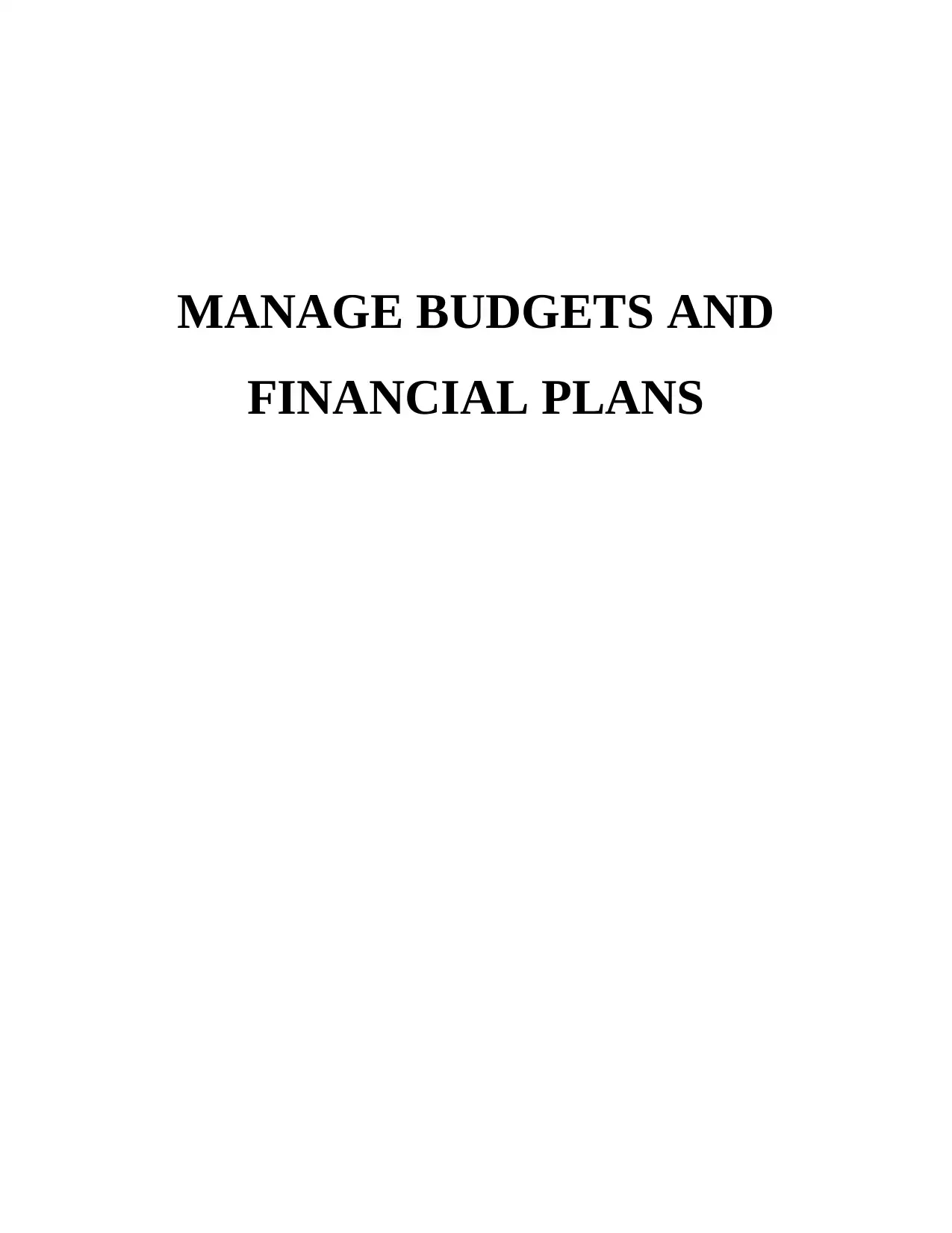
MANAGE BUDGETS AND
FINANCIAL PLANS
FINANCIAL PLANS
Paraphrase This Document
Need a fresh take? Get an instant paraphrase of this document with our AI Paraphraser
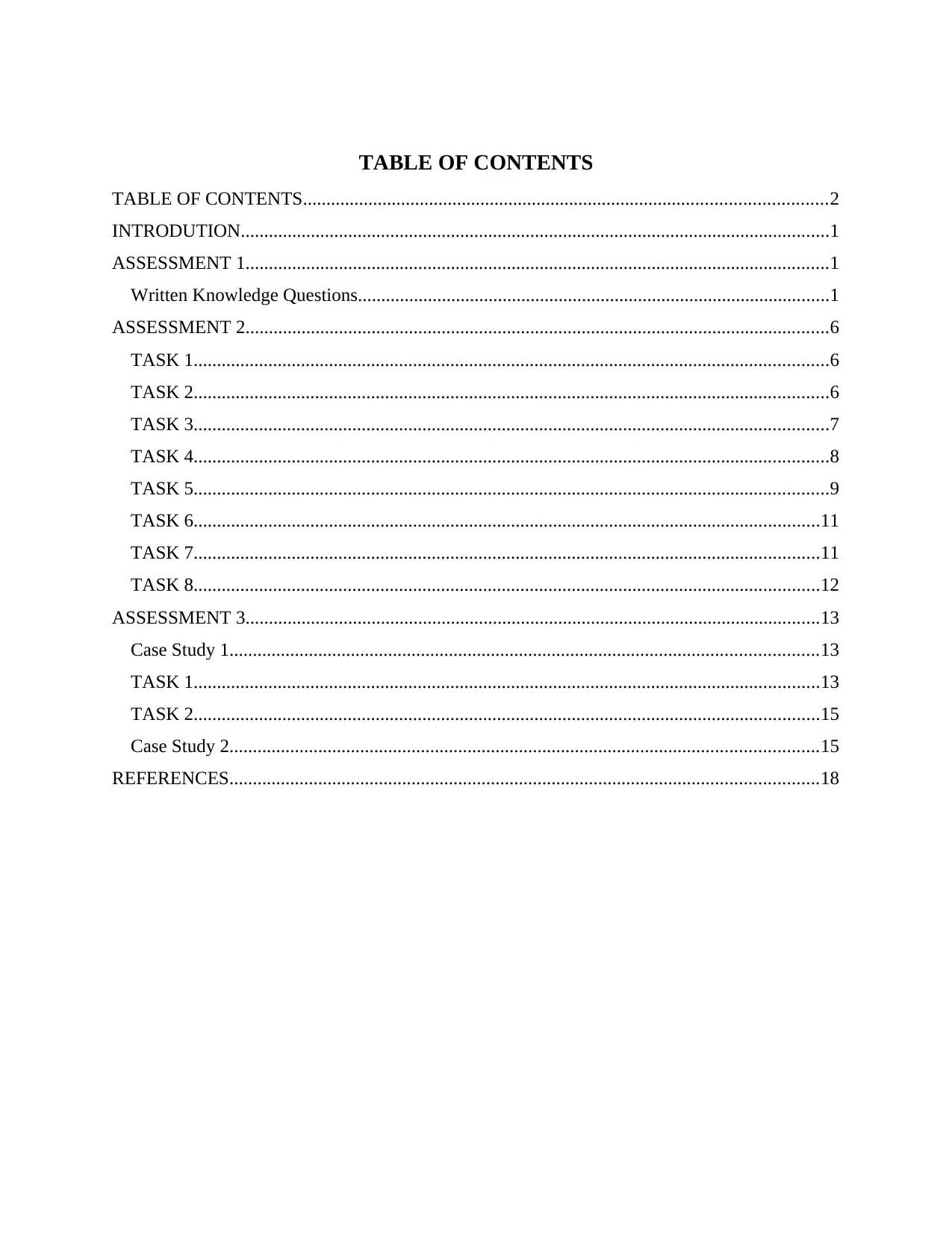
TABLE OF CONTENTS
TABLE OF CONTENTS................................................................................................................2
INTRODUTION..............................................................................................................................1
ASSESSMENT 1.............................................................................................................................1
Written Knowledge Questions.....................................................................................................1
ASSESSMENT 2.............................................................................................................................6
TASK 1........................................................................................................................................6
TASK 2........................................................................................................................................6
TASK 3........................................................................................................................................7
TASK 4........................................................................................................................................8
TASK 5........................................................................................................................................9
TASK 6......................................................................................................................................11
TASK 7......................................................................................................................................11
TASK 8......................................................................................................................................12
ASSESSMENT 3...........................................................................................................................13
Case Study 1..............................................................................................................................13
TASK 1......................................................................................................................................13
TASK 2......................................................................................................................................15
Case Study 2..............................................................................................................................15
REFERENCES..............................................................................................................................18
TABLE OF CONTENTS................................................................................................................2
INTRODUTION..............................................................................................................................1
ASSESSMENT 1.............................................................................................................................1
Written Knowledge Questions.....................................................................................................1
ASSESSMENT 2.............................................................................................................................6
TASK 1........................................................................................................................................6
TASK 2........................................................................................................................................6
TASK 3........................................................................................................................................7
TASK 4........................................................................................................................................8
TASK 5........................................................................................................................................9
TASK 6......................................................................................................................................11
TASK 7......................................................................................................................................11
TASK 8......................................................................................................................................12
ASSESSMENT 3...........................................................................................................................13
Case Study 1..............................................................................................................................13
TASK 1......................................................................................................................................13
TASK 2......................................................................................................................................15
Case Study 2..............................................................................................................................15
REFERENCES..............................................................................................................................18
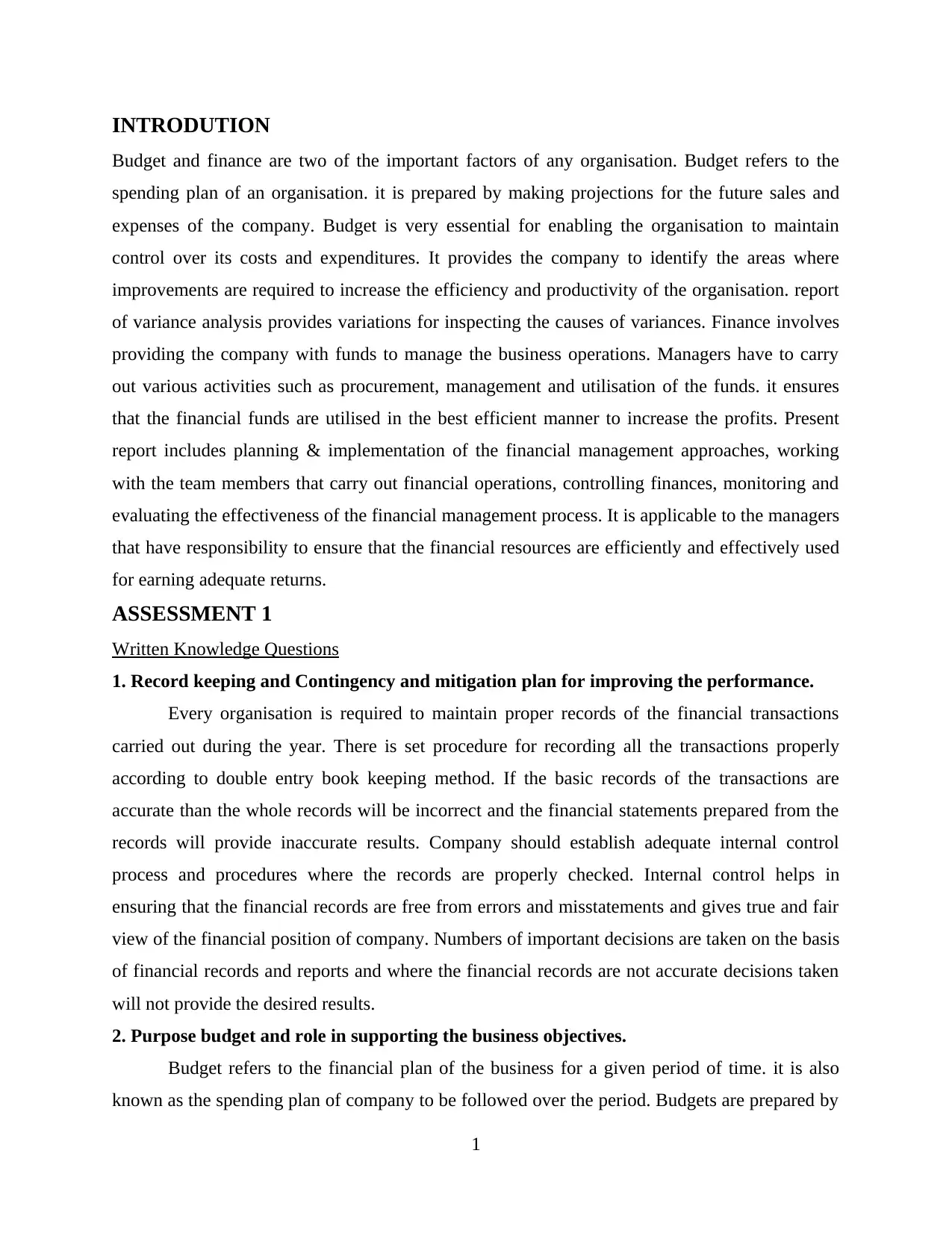
INTRODUTION
Budget and finance are two of the important factors of any organisation. Budget refers to the
spending plan of an organisation. it is prepared by making projections for the future sales and
expenses of the company. Budget is very essential for enabling the organisation to maintain
control over its costs and expenditures. It provides the company to identify the areas where
improvements are required to increase the efficiency and productivity of the organisation. report
of variance analysis provides variations for inspecting the causes of variances. Finance involves
providing the company with funds to manage the business operations. Managers have to carry
out various activities such as procurement, management and utilisation of the funds. it ensures
that the financial funds are utilised in the best efficient manner to increase the profits. Present
report includes planning & implementation of the financial management approaches, working
with the team members that carry out financial operations, controlling finances, monitoring and
evaluating the effectiveness of the financial management process. It is applicable to the managers
that have responsibility to ensure that the financial resources are efficiently and effectively used
for earning adequate returns.
ASSESSMENT 1
Written Knowledge Questions
1. Record keeping and Contingency and mitigation plan for improving the performance.
Every organisation is required to maintain proper records of the financial transactions
carried out during the year. There is set procedure for recording all the transactions properly
according to double entry book keeping method. If the basic records of the transactions are
accurate than the whole records will be incorrect and the financial statements prepared from the
records will provide inaccurate results. Company should establish adequate internal control
process and procedures where the records are properly checked. Internal control helps in
ensuring that the financial records are free from errors and misstatements and gives true and fair
view of the financial position of company. Numbers of important decisions are taken on the basis
of financial records and reports and where the financial records are not accurate decisions taken
will not provide the desired results.
2. Purpose budget and role in supporting the business objectives.
Budget refers to the financial plan of the business for a given period of time. it is also
known as the spending plan of company to be followed over the period. Budgets are prepared by
1
Budget and finance are two of the important factors of any organisation. Budget refers to the
spending plan of an organisation. it is prepared by making projections for the future sales and
expenses of the company. Budget is very essential for enabling the organisation to maintain
control over its costs and expenditures. It provides the company to identify the areas where
improvements are required to increase the efficiency and productivity of the organisation. report
of variance analysis provides variations for inspecting the causes of variances. Finance involves
providing the company with funds to manage the business operations. Managers have to carry
out various activities such as procurement, management and utilisation of the funds. it ensures
that the financial funds are utilised in the best efficient manner to increase the profits. Present
report includes planning & implementation of the financial management approaches, working
with the team members that carry out financial operations, controlling finances, monitoring and
evaluating the effectiveness of the financial management process. It is applicable to the managers
that have responsibility to ensure that the financial resources are efficiently and effectively used
for earning adequate returns.
ASSESSMENT 1
Written Knowledge Questions
1. Record keeping and Contingency and mitigation plan for improving the performance.
Every organisation is required to maintain proper records of the financial transactions
carried out during the year. There is set procedure for recording all the transactions properly
according to double entry book keeping method. If the basic records of the transactions are
accurate than the whole records will be incorrect and the financial statements prepared from the
records will provide inaccurate results. Company should establish adequate internal control
process and procedures where the records are properly checked. Internal control helps in
ensuring that the financial records are free from errors and misstatements and gives true and fair
view of the financial position of company. Numbers of important decisions are taken on the basis
of financial records and reports and where the financial records are not accurate decisions taken
will not provide the desired results.
2. Purpose budget and role in supporting the business objectives.
Budget refers to the financial plan of the business for a given period of time. it is also
known as the spending plan of company to be followed over the period. Budgets are prepared by
1
⊘ This is a preview!⊘
Do you want full access?
Subscribe today to unlock all pages.

Trusted by 1+ million students worldwide
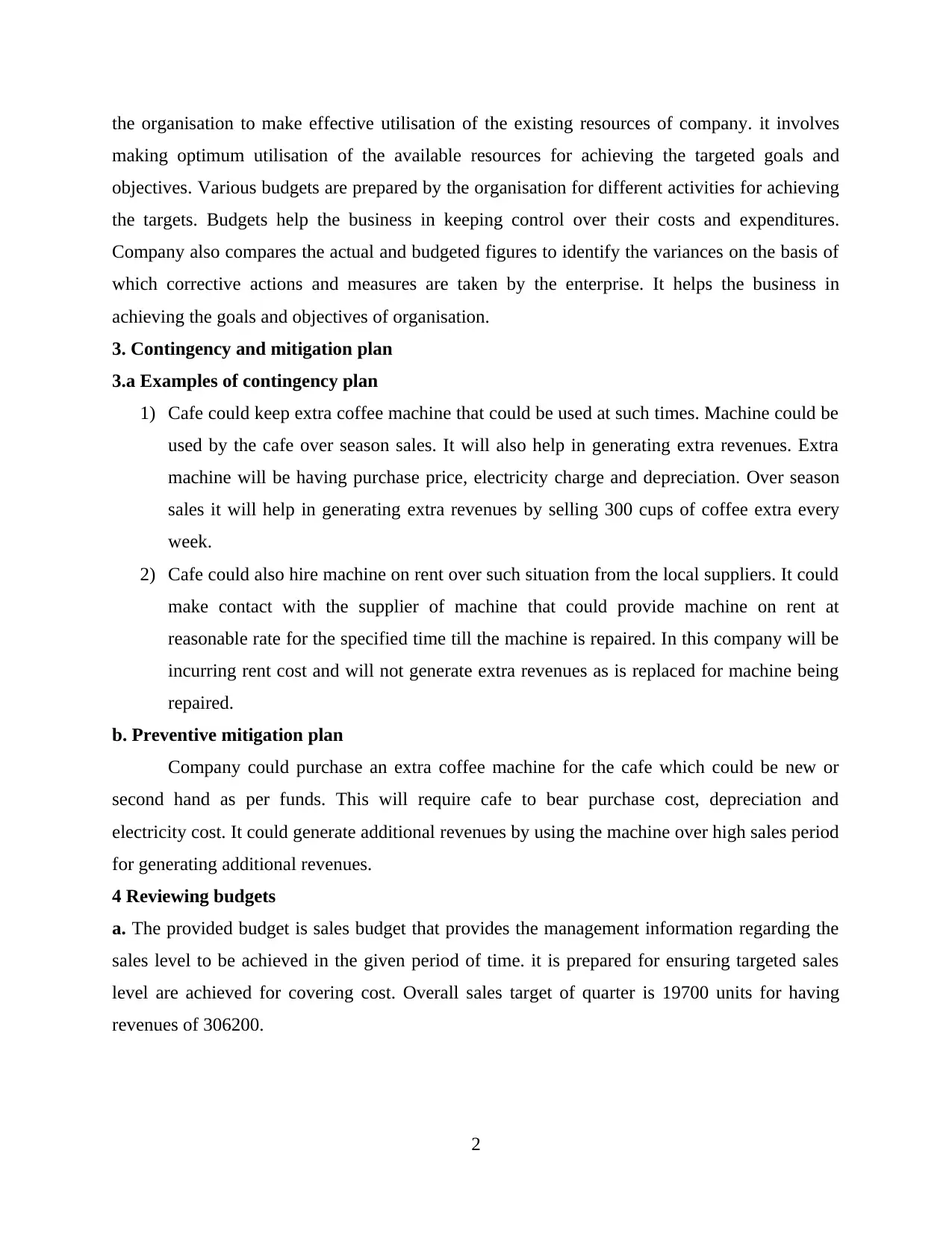
the organisation to make effective utilisation of the existing resources of company. it involves
making optimum utilisation of the available resources for achieving the targeted goals and
objectives. Various budgets are prepared by the organisation for different activities for achieving
the targets. Budgets help the business in keeping control over their costs and expenditures.
Company also compares the actual and budgeted figures to identify the variances on the basis of
which corrective actions and measures are taken by the enterprise. It helps the business in
achieving the goals and objectives of organisation.
3. Contingency and mitigation plan
3.a Examples of contingency plan
1) Cafe could keep extra coffee machine that could be used at such times. Machine could be
used by the cafe over season sales. It will also help in generating extra revenues. Extra
machine will be having purchase price, electricity charge and depreciation. Over season
sales it will help in generating extra revenues by selling 300 cups of coffee extra every
week.
2) Cafe could also hire machine on rent over such situation from the local suppliers. It could
make contact with the supplier of machine that could provide machine on rent at
reasonable rate for the specified time till the machine is repaired. In this company will be
incurring rent cost and will not generate extra revenues as is replaced for machine being
repaired.
b. Preventive mitigation plan
Company could purchase an extra coffee machine for the cafe which could be new or
second hand as per funds. This will require cafe to bear purchase cost, depreciation and
electricity cost. It could generate additional revenues by using the machine over high sales period
for generating additional revenues.
4 Reviewing budgets
a. The provided budget is sales budget that provides the management information regarding the
sales level to be achieved in the given period of time. it is prepared for ensuring targeted sales
level are achieved for covering cost. Overall sales target of quarter is 19700 units for having
revenues of 306200.
2
making optimum utilisation of the available resources for achieving the targeted goals and
objectives. Various budgets are prepared by the organisation for different activities for achieving
the targets. Budgets help the business in keeping control over their costs and expenditures.
Company also compares the actual and budgeted figures to identify the variances on the basis of
which corrective actions and measures are taken by the enterprise. It helps the business in
achieving the goals and objectives of organisation.
3. Contingency and mitigation plan
3.a Examples of contingency plan
1) Cafe could keep extra coffee machine that could be used at such times. Machine could be
used by the cafe over season sales. It will also help in generating extra revenues. Extra
machine will be having purchase price, electricity charge and depreciation. Over season
sales it will help in generating extra revenues by selling 300 cups of coffee extra every
week.
2) Cafe could also hire machine on rent over such situation from the local suppliers. It could
make contact with the supplier of machine that could provide machine on rent at
reasonable rate for the specified time till the machine is repaired. In this company will be
incurring rent cost and will not generate extra revenues as is replaced for machine being
repaired.
b. Preventive mitigation plan
Company could purchase an extra coffee machine for the cafe which could be new or
second hand as per funds. This will require cafe to bear purchase cost, depreciation and
electricity cost. It could generate additional revenues by using the machine over high sales period
for generating additional revenues.
4 Reviewing budgets
a. The provided budget is sales budget that provides the management information regarding the
sales level to be achieved in the given period of time. it is prepared for ensuring targeted sales
level are achieved for covering cost. Overall sales target of quarter is 19700 units for having
revenues of 306200.
2
Paraphrase This Document
Need a fresh take? Get an instant paraphrase of this document with our AI Paraphraser
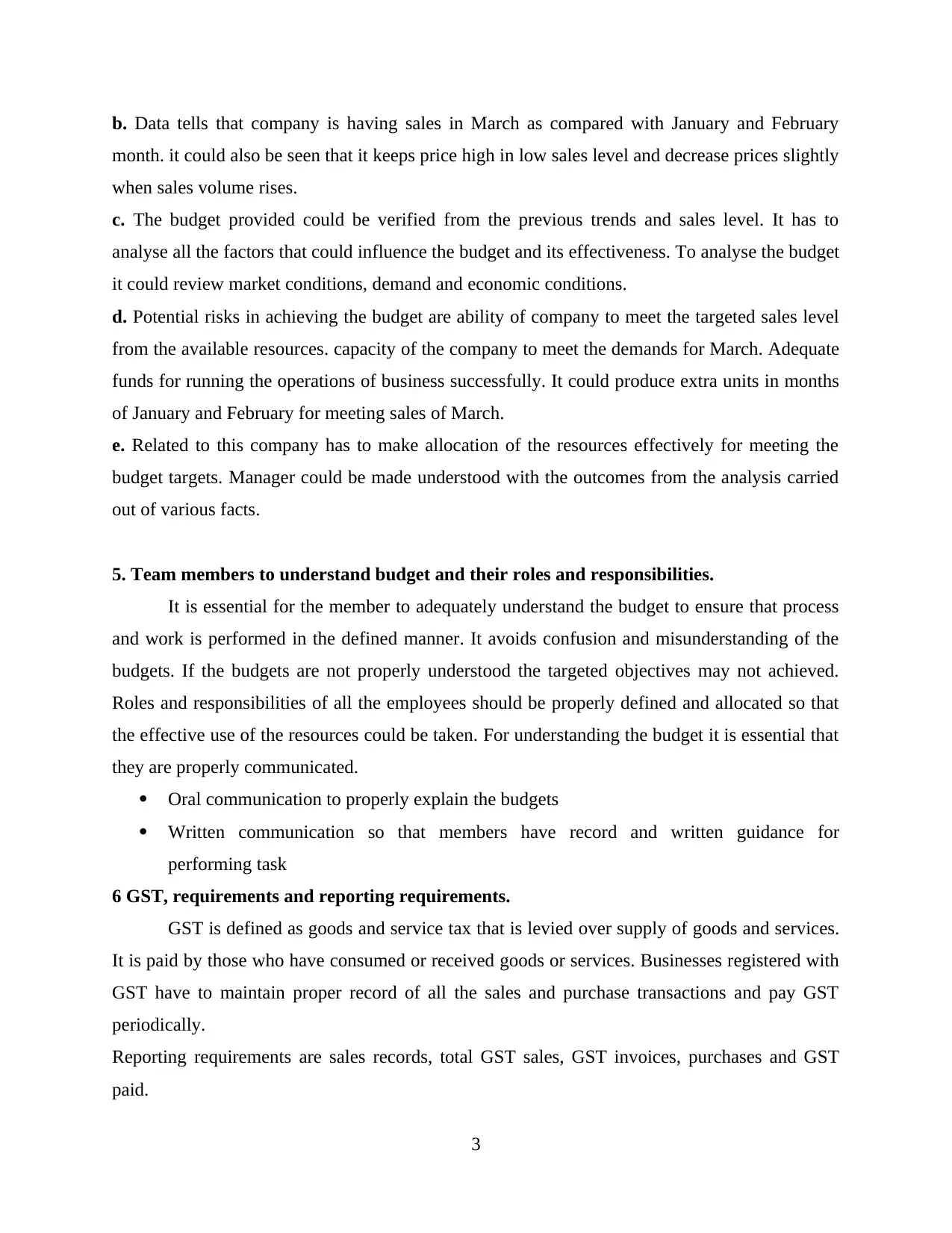
b. Data tells that company is having sales in March as compared with January and February
month. it could also be seen that it keeps price high in low sales level and decrease prices slightly
when sales volume rises.
c. The budget provided could be verified from the previous trends and sales level. It has to
analyse all the factors that could influence the budget and its effectiveness. To analyse the budget
it could review market conditions, demand and economic conditions.
d. Potential risks in achieving the budget are ability of company to meet the targeted sales level
from the available resources. capacity of the company to meet the demands for March. Adequate
funds for running the operations of business successfully. It could produce extra units in months
of January and February for meeting sales of March.
e. Related to this company has to make allocation of the resources effectively for meeting the
budget targets. Manager could be made understood with the outcomes from the analysis carried
out of various facts.
5. Team members to understand budget and their roles and responsibilities.
It is essential for the member to adequately understand the budget to ensure that process
and work is performed in the defined manner. It avoids confusion and misunderstanding of the
budgets. If the budgets are not properly understood the targeted objectives may not achieved.
Roles and responsibilities of all the employees should be properly defined and allocated so that
the effective use of the resources could be taken. For understanding the budget it is essential that
they are properly communicated.
Oral communication to properly explain the budgets
Written communication so that members have record and written guidance for
performing task
6 GST, requirements and reporting requirements.
GST is defined as goods and service tax that is levied over supply of goods and services.
It is paid by those who have consumed or received goods or services. Businesses registered with
GST have to maintain proper record of all the sales and purchase transactions and pay GST
periodically.
Reporting requirements are sales records, total GST sales, GST invoices, purchases and GST
paid.
3
month. it could also be seen that it keeps price high in low sales level and decrease prices slightly
when sales volume rises.
c. The budget provided could be verified from the previous trends and sales level. It has to
analyse all the factors that could influence the budget and its effectiveness. To analyse the budget
it could review market conditions, demand and economic conditions.
d. Potential risks in achieving the budget are ability of company to meet the targeted sales level
from the available resources. capacity of the company to meet the demands for March. Adequate
funds for running the operations of business successfully. It could produce extra units in months
of January and February for meeting sales of March.
e. Related to this company has to make allocation of the resources effectively for meeting the
budget targets. Manager could be made understood with the outcomes from the analysis carried
out of various facts.
5. Team members to understand budget and their roles and responsibilities.
It is essential for the member to adequately understand the budget to ensure that process
and work is performed in the defined manner. It avoids confusion and misunderstanding of the
budgets. If the budgets are not properly understood the targeted objectives may not achieved.
Roles and responsibilities of all the employees should be properly defined and allocated so that
the effective use of the resources could be taken. For understanding the budget it is essential that
they are properly communicated.
Oral communication to properly explain the budgets
Written communication so that members have record and written guidance for
performing task
6 GST, requirements and reporting requirements.
GST is defined as goods and service tax that is levied over supply of goods and services.
It is paid by those who have consumed or received goods or services. Businesses registered with
GST have to maintain proper record of all the sales and purchase transactions and pay GST
periodically.
Reporting requirements are sales records, total GST sales, GST invoices, purchases and GST
paid.
3
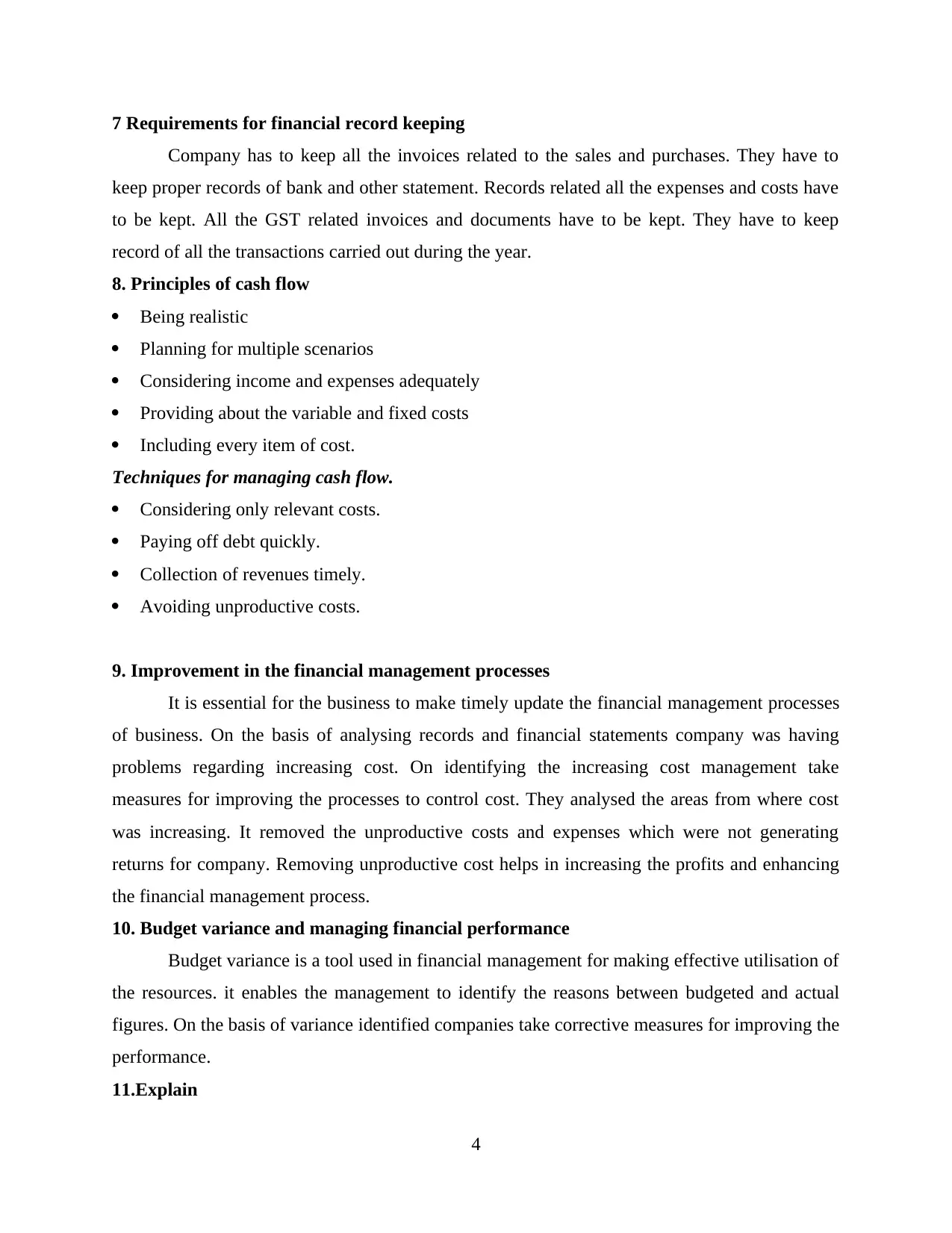
7 Requirements for financial record keeping
Company has to keep all the invoices related to the sales and purchases. They have to
keep proper records of bank and other statement. Records related all the expenses and costs have
to be kept. All the GST related invoices and documents have to be kept. They have to keep
record of all the transactions carried out during the year.
8. Principles of cash flow
Being realistic
Planning for multiple scenarios
Considering income and expenses adequately
Providing about the variable and fixed costs
Including every item of cost.
Techniques for managing cash flow.
Considering only relevant costs.
Paying off debt quickly.
Collection of revenues timely.
Avoiding unproductive costs.
9. Improvement in the financial management processes
It is essential for the business to make timely update the financial management processes
of business. On the basis of analysing records and financial statements company was having
problems regarding increasing cost. On identifying the increasing cost management take
measures for improving the processes to control cost. They analysed the areas from where cost
was increasing. It removed the unproductive costs and expenses which were not generating
returns for company. Removing unproductive cost helps in increasing the profits and enhancing
the financial management process.
10. Budget variance and managing financial performance
Budget variance is a tool used in financial management for making effective utilisation of
the resources. it enables the management to identify the reasons between budgeted and actual
figures. On the basis of variance identified companies take corrective measures for improving the
performance.
11.Explain
4
Company has to keep all the invoices related to the sales and purchases. They have to
keep proper records of bank and other statement. Records related all the expenses and costs have
to be kept. All the GST related invoices and documents have to be kept. They have to keep
record of all the transactions carried out during the year.
8. Principles of cash flow
Being realistic
Planning for multiple scenarios
Considering income and expenses adequately
Providing about the variable and fixed costs
Including every item of cost.
Techniques for managing cash flow.
Considering only relevant costs.
Paying off debt quickly.
Collection of revenues timely.
Avoiding unproductive costs.
9. Improvement in the financial management processes
It is essential for the business to make timely update the financial management processes
of business. On the basis of analysing records and financial statements company was having
problems regarding increasing cost. On identifying the increasing cost management take
measures for improving the processes to control cost. They analysed the areas from where cost
was increasing. It removed the unproductive costs and expenses which were not generating
returns for company. Removing unproductive cost helps in increasing the profits and enhancing
the financial management process.
10. Budget variance and managing financial performance
Budget variance is a tool used in financial management for making effective utilisation of
the resources. it enables the management to identify the reasons between budgeted and actual
figures. On the basis of variance identified companies take corrective measures for improving the
performance.
11.Explain
4
⊘ This is a preview!⊘
Do you want full access?
Subscribe today to unlock all pages.

Trusted by 1+ million students worldwide
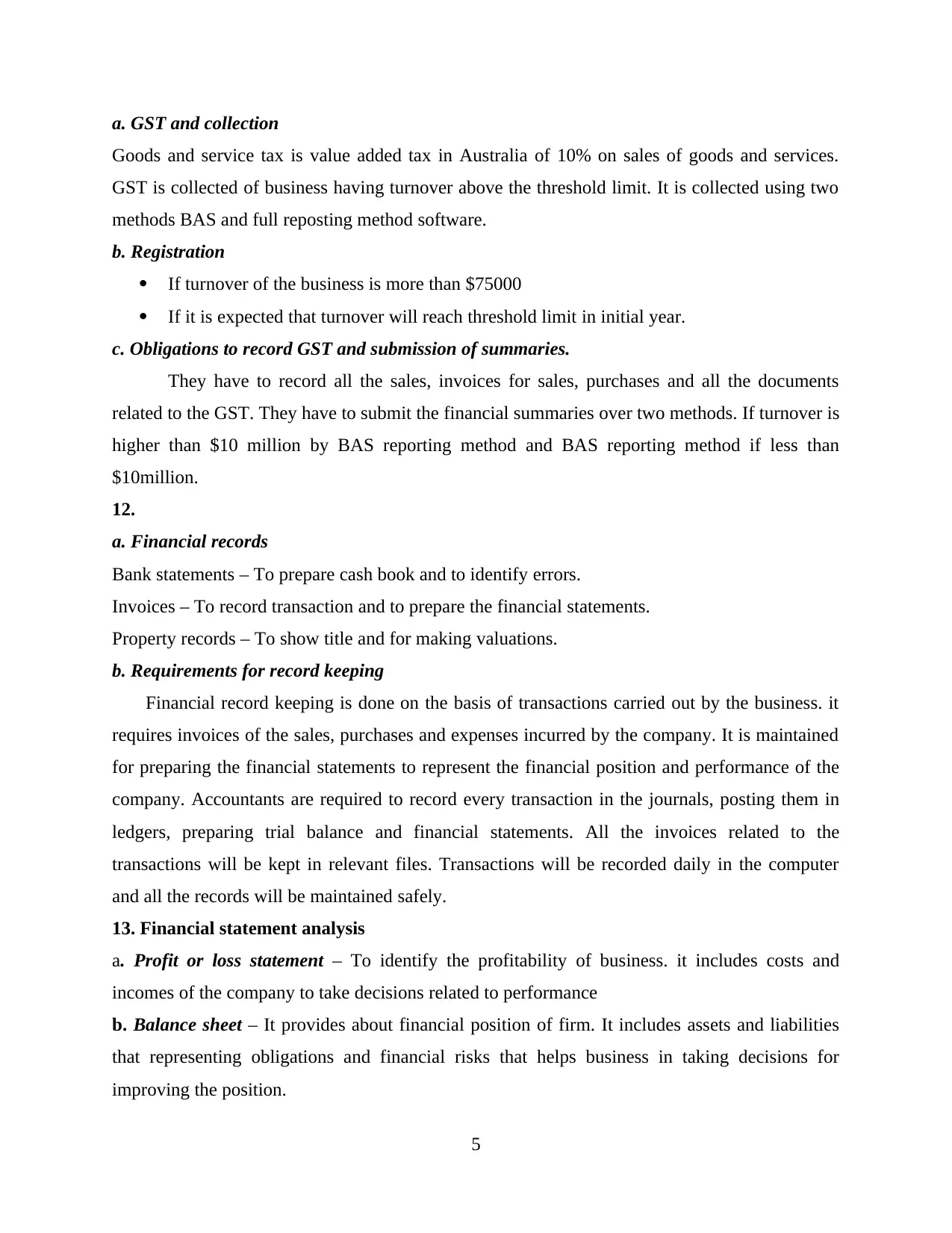
a. GST and collection
Goods and service tax is value added tax in Australia of 10% on sales of goods and services.
GST is collected of business having turnover above the threshold limit. It is collected using two
methods BAS and full reposting method software.
b. Registration
If turnover of the business is more than $75000
If it is expected that turnover will reach threshold limit in initial year.
c. Obligations to record GST and submission of summaries.
They have to record all the sales, invoices for sales, purchases and all the documents
related to the GST. They have to submit the financial summaries over two methods. If turnover is
higher than $10 million by BAS reporting method and BAS reporting method if less than
$10million.
12.
a. Financial records
Bank statements – To prepare cash book and to identify errors.
Invoices – To record transaction and to prepare the financial statements.
Property records – To show title and for making valuations.
b. Requirements for record keeping
Financial record keeping is done on the basis of transactions carried out by the business. it
requires invoices of the sales, purchases and expenses incurred by the company. It is maintained
for preparing the financial statements to represent the financial position and performance of the
company. Accountants are required to record every transaction in the journals, posting them in
ledgers, preparing trial balance and financial statements. All the invoices related to the
transactions will be kept in relevant files. Transactions will be recorded daily in the computer
and all the records will be maintained safely.
13. Financial statement analysis
a. Profit or loss statement – To identify the profitability of business. it includes costs and
incomes of the company to take decisions related to performance
b. Balance sheet – It provides about financial position of firm. It includes assets and liabilities
that representing obligations and financial risks that helps business in taking decisions for
improving the position.
5
Goods and service tax is value added tax in Australia of 10% on sales of goods and services.
GST is collected of business having turnover above the threshold limit. It is collected using two
methods BAS and full reposting method software.
b. Registration
If turnover of the business is more than $75000
If it is expected that turnover will reach threshold limit in initial year.
c. Obligations to record GST and submission of summaries.
They have to record all the sales, invoices for sales, purchases and all the documents
related to the GST. They have to submit the financial summaries over two methods. If turnover is
higher than $10 million by BAS reporting method and BAS reporting method if less than
$10million.
12.
a. Financial records
Bank statements – To prepare cash book and to identify errors.
Invoices – To record transaction and to prepare the financial statements.
Property records – To show title and for making valuations.
b. Requirements for record keeping
Financial record keeping is done on the basis of transactions carried out by the business. it
requires invoices of the sales, purchases and expenses incurred by the company. It is maintained
for preparing the financial statements to represent the financial position and performance of the
company. Accountants are required to record every transaction in the journals, posting them in
ledgers, preparing trial balance and financial statements. All the invoices related to the
transactions will be kept in relevant files. Transactions will be recorded daily in the computer
and all the records will be maintained safely.
13. Financial statement analysis
a. Profit or loss statement – To identify the profitability of business. it includes costs and
incomes of the company to take decisions related to performance
b. Balance sheet – It provides about financial position of firm. It includes assets and liabilities
that representing obligations and financial risks that helps business in taking decisions for
improving the position.
5
Paraphrase This Document
Need a fresh take? Get an instant paraphrase of this document with our AI Paraphraser
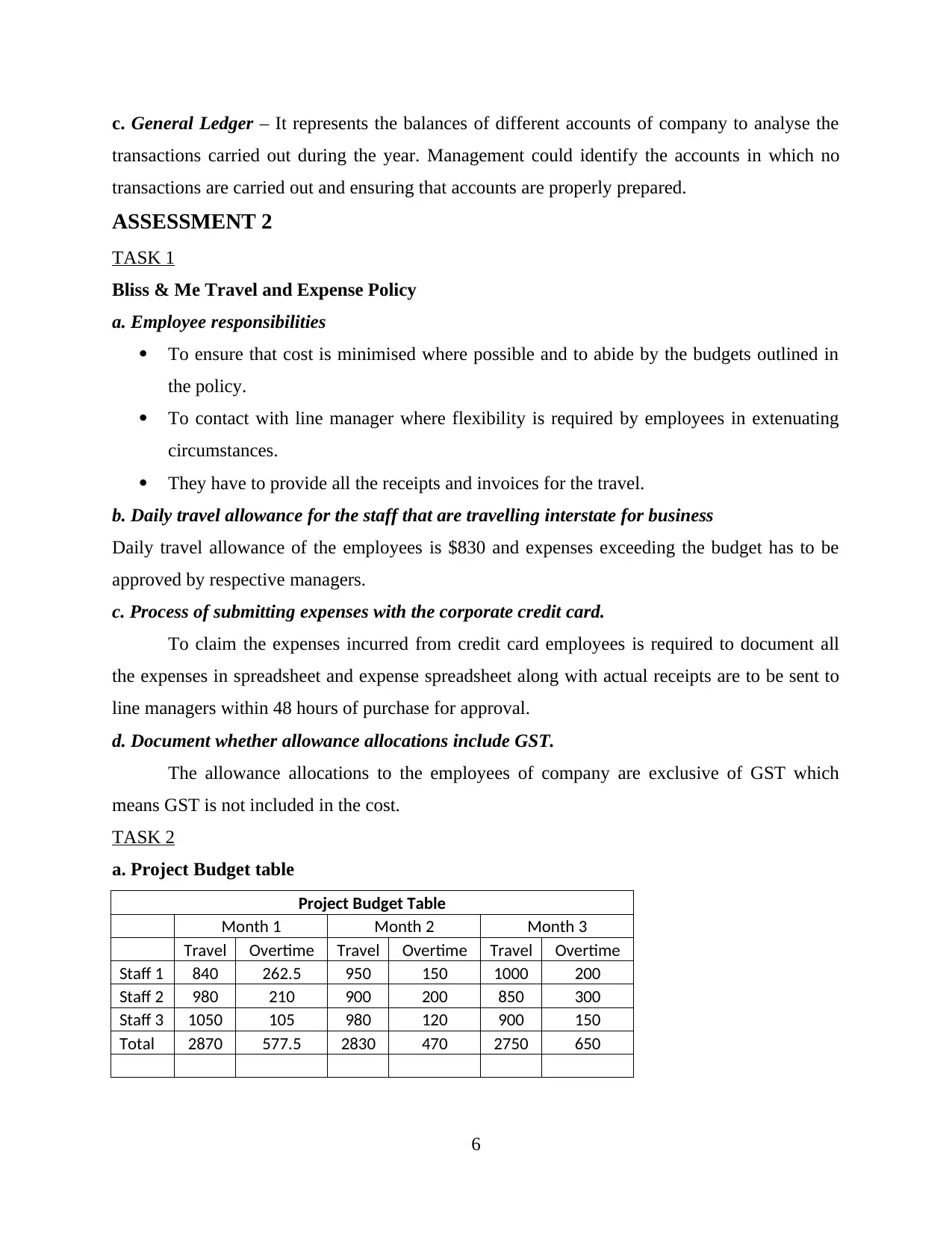
c. General Ledger – It represents the balances of different accounts of company to analyse the
transactions carried out during the year. Management could identify the accounts in which no
transactions are carried out and ensuring that accounts are properly prepared.
ASSESSMENT 2
TASK 1
Bliss & Me Travel and Expense Policy
a. Employee responsibilities
To ensure that cost is minimised where possible and to abide by the budgets outlined in
the policy.
To contact with line manager where flexibility is required by employees in extenuating
circumstances.
They have to provide all the receipts and invoices for the travel.
b. Daily travel allowance for the staff that are travelling interstate for business
Daily travel allowance of the employees is $830 and expenses exceeding the budget has to be
approved by respective managers.
c. Process of submitting expenses with the corporate credit card.
To claim the expenses incurred from credit card employees is required to document all
the expenses in spreadsheet and expense spreadsheet along with actual receipts are to be sent to
line managers within 48 hours of purchase for approval.
d. Document whether allowance allocations include GST.
The allowance allocations to the employees of company are exclusive of GST which
means GST is not included in the cost.
TASK 2
a. Project Budget table
Project Budget Table
Month 1 Month 2 Month 3
Travel Overtime Travel Overtime Travel Overtime
Staff 1 840 262.5 950 150 1000 200
Staff 2 980 210 900 200 850 300
Staff 3 1050 105 980 120 900 150
Total 2870 577.5 2830 470 2750 650
6
transactions carried out during the year. Management could identify the accounts in which no
transactions are carried out and ensuring that accounts are properly prepared.
ASSESSMENT 2
TASK 1
Bliss & Me Travel and Expense Policy
a. Employee responsibilities
To ensure that cost is minimised where possible and to abide by the budgets outlined in
the policy.
To contact with line manager where flexibility is required by employees in extenuating
circumstances.
They have to provide all the receipts and invoices for the travel.
b. Daily travel allowance for the staff that are travelling interstate for business
Daily travel allowance of the employees is $830 and expenses exceeding the budget has to be
approved by respective managers.
c. Process of submitting expenses with the corporate credit card.
To claim the expenses incurred from credit card employees is required to document all
the expenses in spreadsheet and expense spreadsheet along with actual receipts are to be sent to
line managers within 48 hours of purchase for approval.
d. Document whether allowance allocations include GST.
The allowance allocations to the employees of company are exclusive of GST which
means GST is not included in the cost.
TASK 2
a. Project Budget table
Project Budget Table
Month 1 Month 2 Month 3
Travel Overtime Travel Overtime Travel Overtime
Staff 1 840 262.5 950 150 1000 200
Staff 2 980 210 900 200 850 300
Staff 3 1050 105 980 120 900 150
Total 2870 577.5 2830 470 2750 650
6
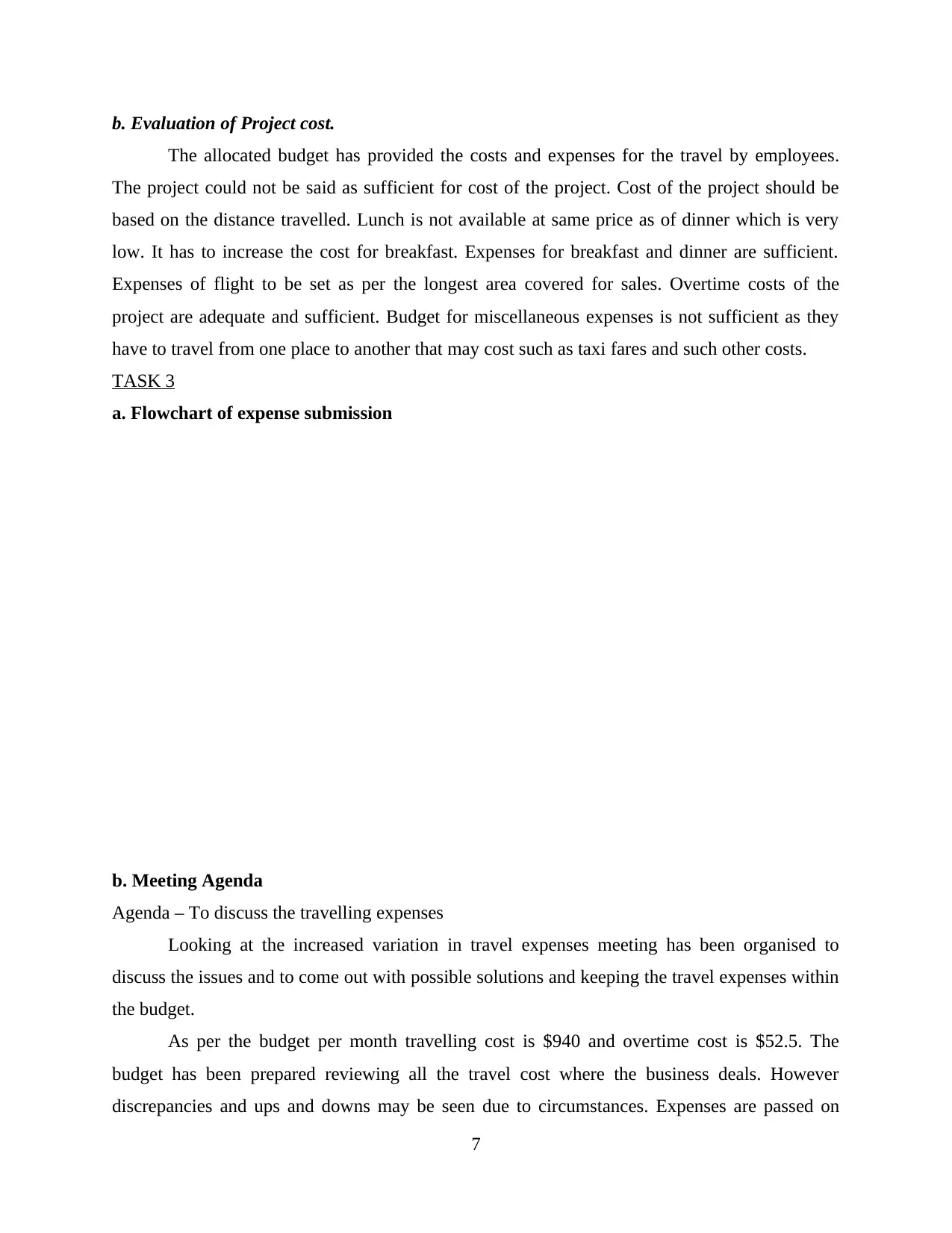
b. Evaluation of Project cost.
The allocated budget has provided the costs and expenses for the travel by employees.
The project could not be said as sufficient for cost of the project. Cost of the project should be
based on the distance travelled. Lunch is not available at same price as of dinner which is very
low. It has to increase the cost for breakfast. Expenses for breakfast and dinner are sufficient.
Expenses of flight to be set as per the longest area covered for sales. Overtime costs of the
project are adequate and sufficient. Budget for miscellaneous expenses is not sufficient as they
have to travel from one place to another that may cost such as taxi fares and such other costs.
TASK 3
a. Flowchart of expense submission
b. Meeting Agenda
Agenda – To discuss the travelling expenses
Looking at the increased variation in travel expenses meeting has been organised to
discuss the issues and to come out with possible solutions and keeping the travel expenses within
the budget.
As per the budget per month travelling cost is $940 and overtime cost is $52.5. The
budget has been prepared reviewing all the travel cost where the business deals. However
discrepancies and ups and downs may be seen due to circumstances. Expenses are passed on
7
The allocated budget has provided the costs and expenses for the travel by employees.
The project could not be said as sufficient for cost of the project. Cost of the project should be
based on the distance travelled. Lunch is not available at same price as of dinner which is very
low. It has to increase the cost for breakfast. Expenses for breakfast and dinner are sufficient.
Expenses of flight to be set as per the longest area covered for sales. Overtime costs of the
project are adequate and sufficient. Budget for miscellaneous expenses is not sufficient as they
have to travel from one place to another that may cost such as taxi fares and such other costs.
TASK 3
a. Flowchart of expense submission
b. Meeting Agenda
Agenda – To discuss the travelling expenses
Looking at the increased variation in travel expenses meeting has been organised to
discuss the issues and to come out with possible solutions and keeping the travel expenses within
the budget.
As per the budget per month travelling cost is $940 and overtime cost is $52.5. The
budget has been prepared reviewing all the travel cost where the business deals. However
discrepancies and ups and downs may be seen due to circumstances. Expenses are passed on
7
⊘ This is a preview!⊘
Do you want full access?
Subscribe today to unlock all pages.

Trusted by 1+ million students worldwide
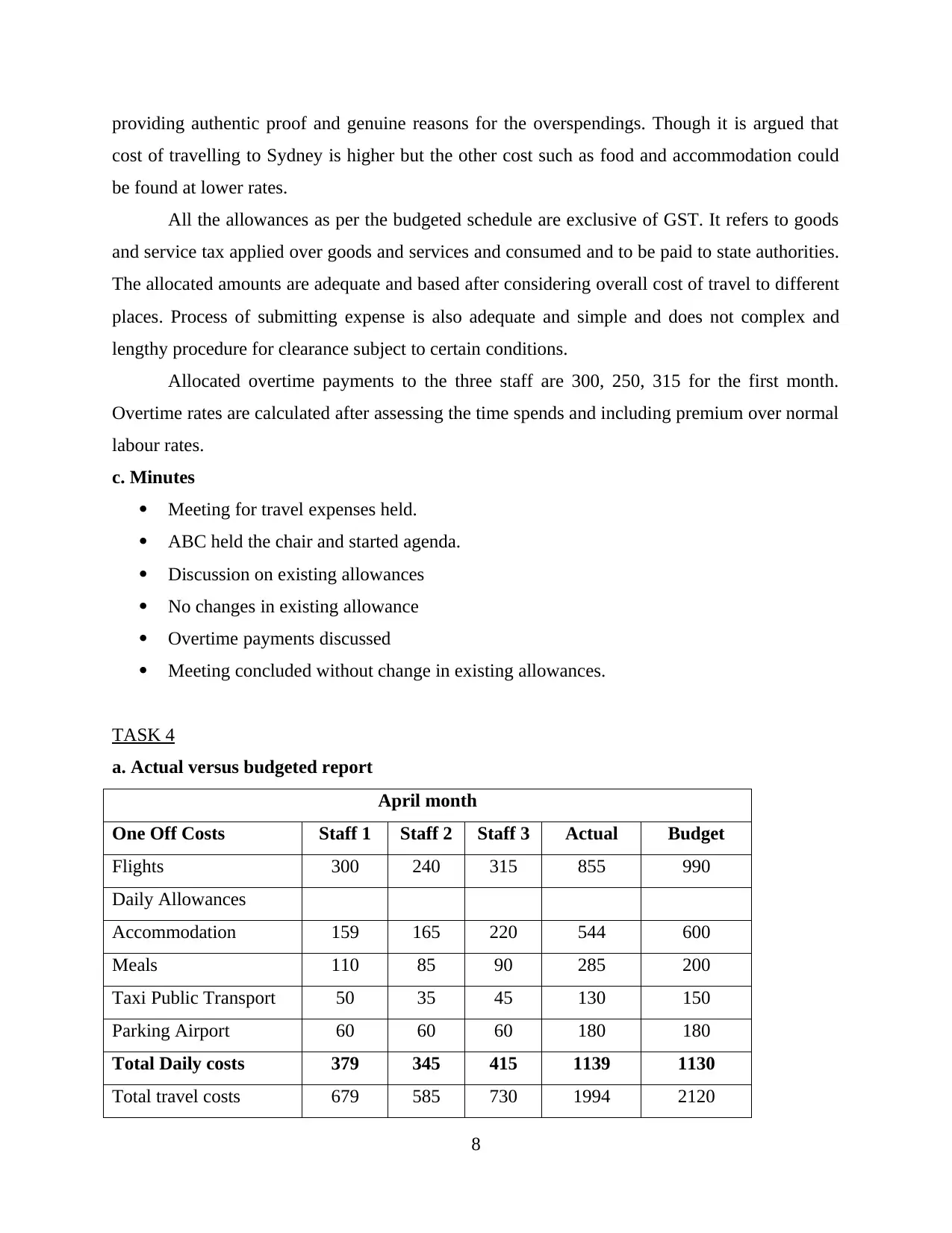
providing authentic proof and genuine reasons for the overspendings. Though it is argued that
cost of travelling to Sydney is higher but the other cost such as food and accommodation could
be found at lower rates.
All the allowances as per the budgeted schedule are exclusive of GST. It refers to goods
and service tax applied over goods and services and consumed and to be paid to state authorities.
The allocated amounts are adequate and based after considering overall cost of travel to different
places. Process of submitting expense is also adequate and simple and does not complex and
lengthy procedure for clearance subject to certain conditions.
Allocated overtime payments to the three staff are 300, 250, 315 for the first month.
Overtime rates are calculated after assessing the time spends and including premium over normal
labour rates.
c. Minutes
Meeting for travel expenses held.
ABC held the chair and started agenda.
Discussion on existing allowances
No changes in existing allowance
Overtime payments discussed
Meeting concluded without change in existing allowances.
TASK 4
a. Actual versus budgeted report
April month
One Off Costs Staff 1 Staff 2 Staff 3 Actual Budget
Flights 300 240 315 855 990
Daily Allowances
Accommodation 159 165 220 544 600
Meals 110 85 90 285 200
Taxi Public Transport 50 35 45 130 150
Parking Airport 60 60 60 180 180
Total Daily costs 379 345 415 1139 1130
Total travel costs 679 585 730 1994 2120
8
cost of travelling to Sydney is higher but the other cost such as food and accommodation could
be found at lower rates.
All the allowances as per the budgeted schedule are exclusive of GST. It refers to goods
and service tax applied over goods and services and consumed and to be paid to state authorities.
The allocated amounts are adequate and based after considering overall cost of travel to different
places. Process of submitting expense is also adequate and simple and does not complex and
lengthy procedure for clearance subject to certain conditions.
Allocated overtime payments to the three staff are 300, 250, 315 for the first month.
Overtime rates are calculated after assessing the time spends and including premium over normal
labour rates.
c. Minutes
Meeting for travel expenses held.
ABC held the chair and started agenda.
Discussion on existing allowances
No changes in existing allowance
Overtime payments discussed
Meeting concluded without change in existing allowances.
TASK 4
a. Actual versus budgeted report
April month
One Off Costs Staff 1 Staff 2 Staff 3 Actual Budget
Flights 300 240 315 855 990
Daily Allowances
Accommodation 159 165 220 544 600
Meals 110 85 90 285 200
Taxi Public Transport 50 35 45 130 150
Parking Airport 60 60 60 180 180
Total Daily costs 379 345 415 1139 1130
Total travel costs 679 585 730 1994 2120
8
Paraphrase This Document
Need a fresh take? Get an instant paraphrase of this document with our AI Paraphraser
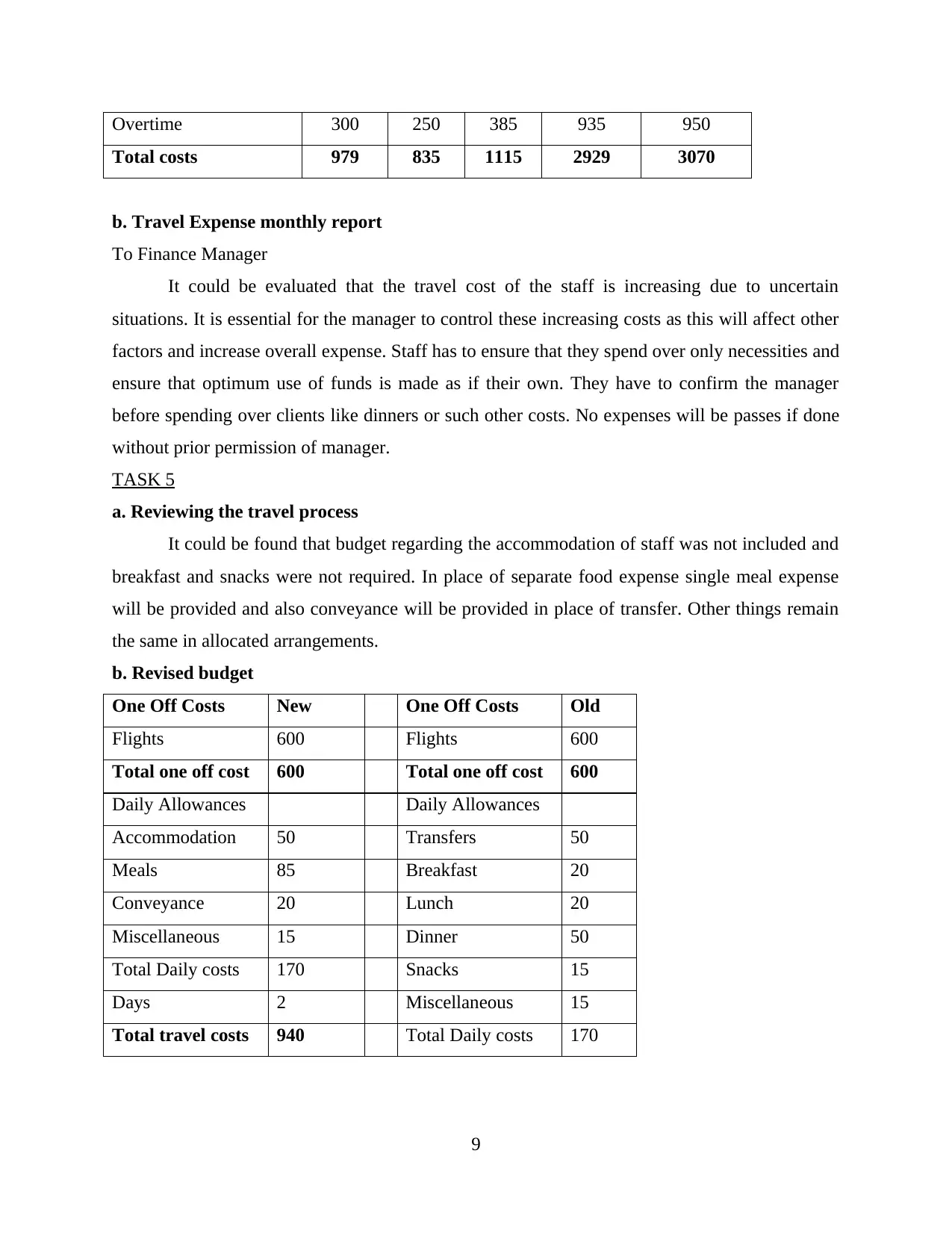
Overtime 300 250 385 935 950
Total costs 979 835 1115 2929 3070
b. Travel Expense monthly report
To Finance Manager
It could be evaluated that the travel cost of the staff is increasing due to uncertain
situations. It is essential for the manager to control these increasing costs as this will affect other
factors and increase overall expense. Staff has to ensure that they spend over only necessities and
ensure that optimum use of funds is made as if their own. They have to confirm the manager
before spending over clients like dinners or such other costs. No expenses will be passes if done
without prior permission of manager.
TASK 5
a. Reviewing the travel process
It could be found that budget regarding the accommodation of staff was not included and
breakfast and snacks were not required. In place of separate food expense single meal expense
will be provided and also conveyance will be provided in place of transfer. Other things remain
the same in allocated arrangements.
b. Revised budget
One Off Costs New One Off Costs Old
Flights 600 Flights 600
Total one off cost 600 Total one off cost 600
Daily Allowances Daily Allowances
Accommodation 50 Transfers 50
Meals 85 Breakfast 20
Conveyance 20 Lunch 20
Miscellaneous 15 Dinner 50
Total Daily costs 170 Snacks 15
Days 2 Miscellaneous 15
Total travel costs 940 Total Daily costs 170
9
Total costs 979 835 1115 2929 3070
b. Travel Expense monthly report
To Finance Manager
It could be evaluated that the travel cost of the staff is increasing due to uncertain
situations. It is essential for the manager to control these increasing costs as this will affect other
factors and increase overall expense. Staff has to ensure that they spend over only necessities and
ensure that optimum use of funds is made as if their own. They have to confirm the manager
before spending over clients like dinners or such other costs. No expenses will be passes if done
without prior permission of manager.
TASK 5
a. Reviewing the travel process
It could be found that budget regarding the accommodation of staff was not included and
breakfast and snacks were not required. In place of separate food expense single meal expense
will be provided and also conveyance will be provided in place of transfer. Other things remain
the same in allocated arrangements.
b. Revised budget
One Off Costs New One Off Costs Old
Flights 600 Flights 600
Total one off cost 600 Total one off cost 600
Daily Allowances Daily Allowances
Accommodation 50 Transfers 50
Meals 85 Breakfast 20
Conveyance 20 Lunch 20
Miscellaneous 15 Dinner 50
Total Daily costs 170 Snacks 15
Days 2 Miscellaneous 15
Total travel costs 940 Total Daily costs 170
9
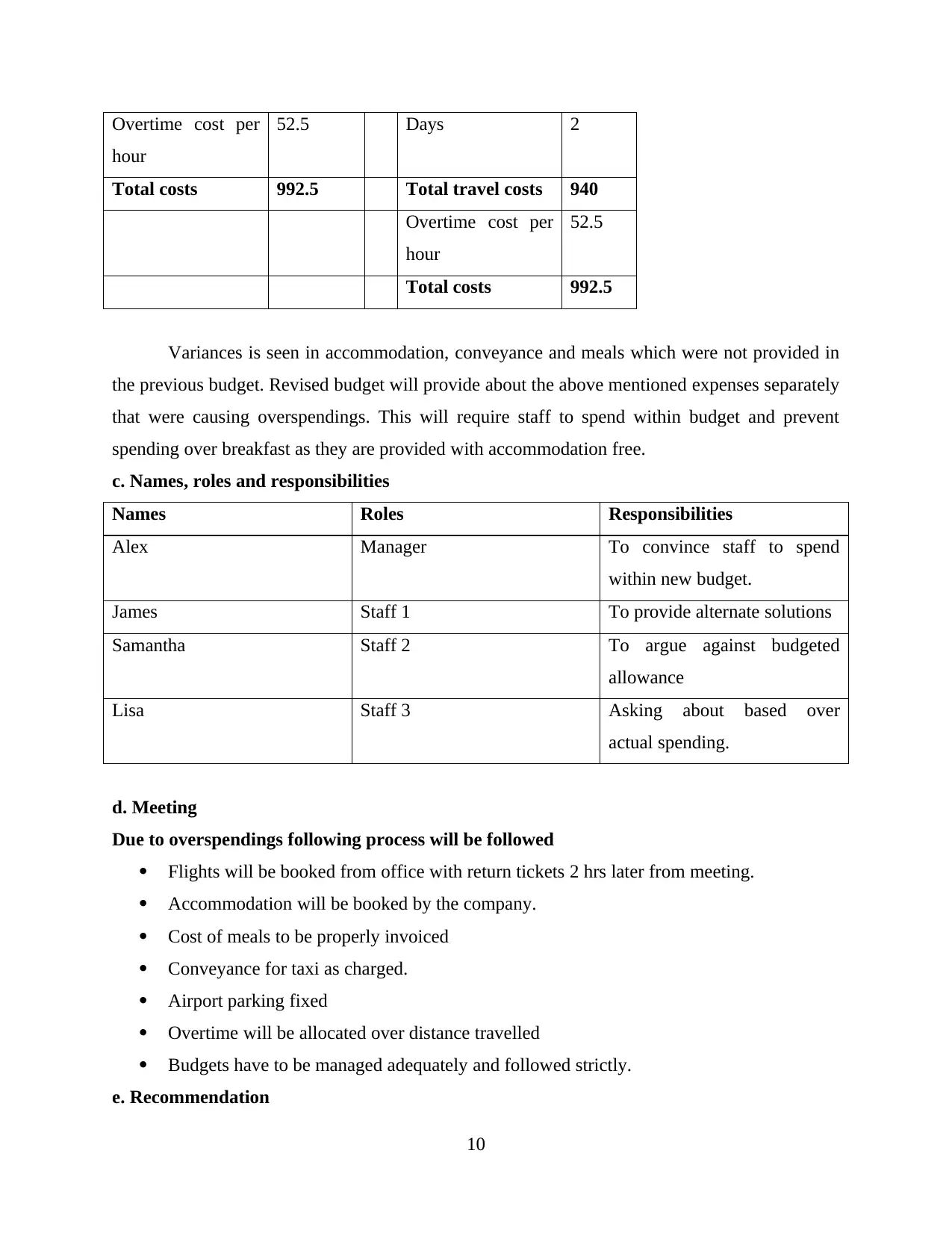
Overtime cost per
hour
52.5 Days 2
Total costs 992.5 Total travel costs 940
Overtime cost per
hour
52.5
Total costs 992.5
Variances is seen in accommodation, conveyance and meals which were not provided in
the previous budget. Revised budget will provide about the above mentioned expenses separately
that were causing overspendings. This will require staff to spend within budget and prevent
spending over breakfast as they are provided with accommodation free.
c. Names, roles and responsibilities
Names Roles Responsibilities
Alex Manager To convince staff to spend
within new budget.
James Staff 1 To provide alternate solutions
Samantha Staff 2 To argue against budgeted
allowance
Lisa Staff 3 Asking about based over
actual spending.
d. Meeting
Due to overspendings following process will be followed
Flights will be booked from office with return tickets 2 hrs later from meeting.
Accommodation will be booked by the company.
Cost of meals to be properly invoiced
Conveyance for taxi as charged.
Airport parking fixed
Overtime will be allocated over distance travelled
Budgets have to be managed adequately and followed strictly.
e. Recommendation
10
hour
52.5 Days 2
Total costs 992.5 Total travel costs 940
Overtime cost per
hour
52.5
Total costs 992.5
Variances is seen in accommodation, conveyance and meals which were not provided in
the previous budget. Revised budget will provide about the above mentioned expenses separately
that were causing overspendings. This will require staff to spend within budget and prevent
spending over breakfast as they are provided with accommodation free.
c. Names, roles and responsibilities
Names Roles Responsibilities
Alex Manager To convince staff to spend
within new budget.
James Staff 1 To provide alternate solutions
Samantha Staff 2 To argue against budgeted
allowance
Lisa Staff 3 Asking about based over
actual spending.
d. Meeting
Due to overspendings following process will be followed
Flights will be booked from office with return tickets 2 hrs later from meeting.
Accommodation will be booked by the company.
Cost of meals to be properly invoiced
Conveyance for taxi as charged.
Airport parking fixed
Overtime will be allocated over distance travelled
Budgets have to be managed adequately and followed strictly.
e. Recommendation
10
⊘ This is a preview!⊘
Do you want full access?
Subscribe today to unlock all pages.

Trusted by 1+ million students worldwide
1 out of 19
Related Documents
Your All-in-One AI-Powered Toolkit for Academic Success.
+13062052269
info@desklib.com
Available 24*7 on WhatsApp / Email
![[object Object]](/_next/static/media/star-bottom.7253800d.svg)
Unlock your academic potential
Copyright © 2020–2025 A2Z Services. All Rights Reserved. Developed and managed by ZUCOL.




